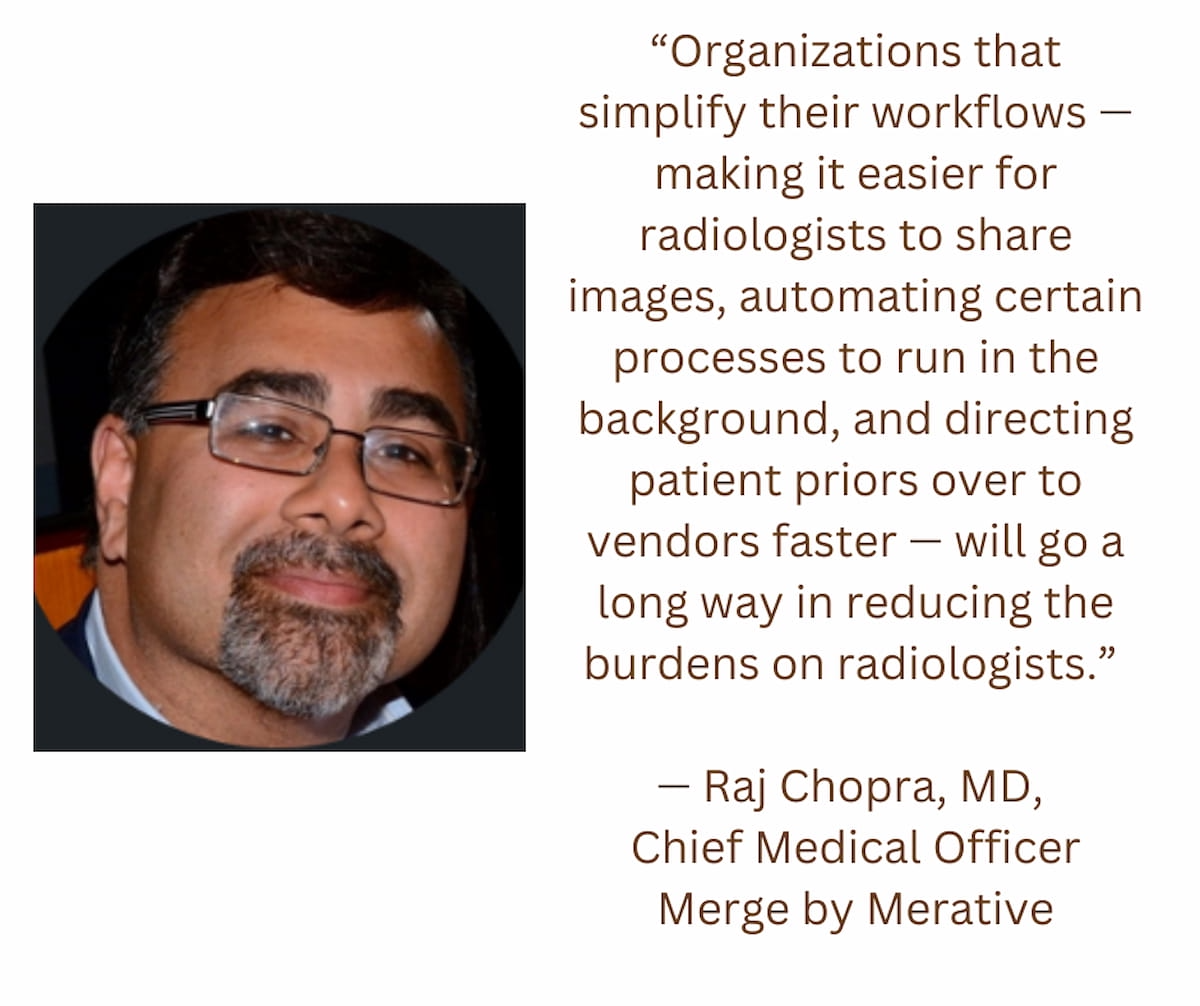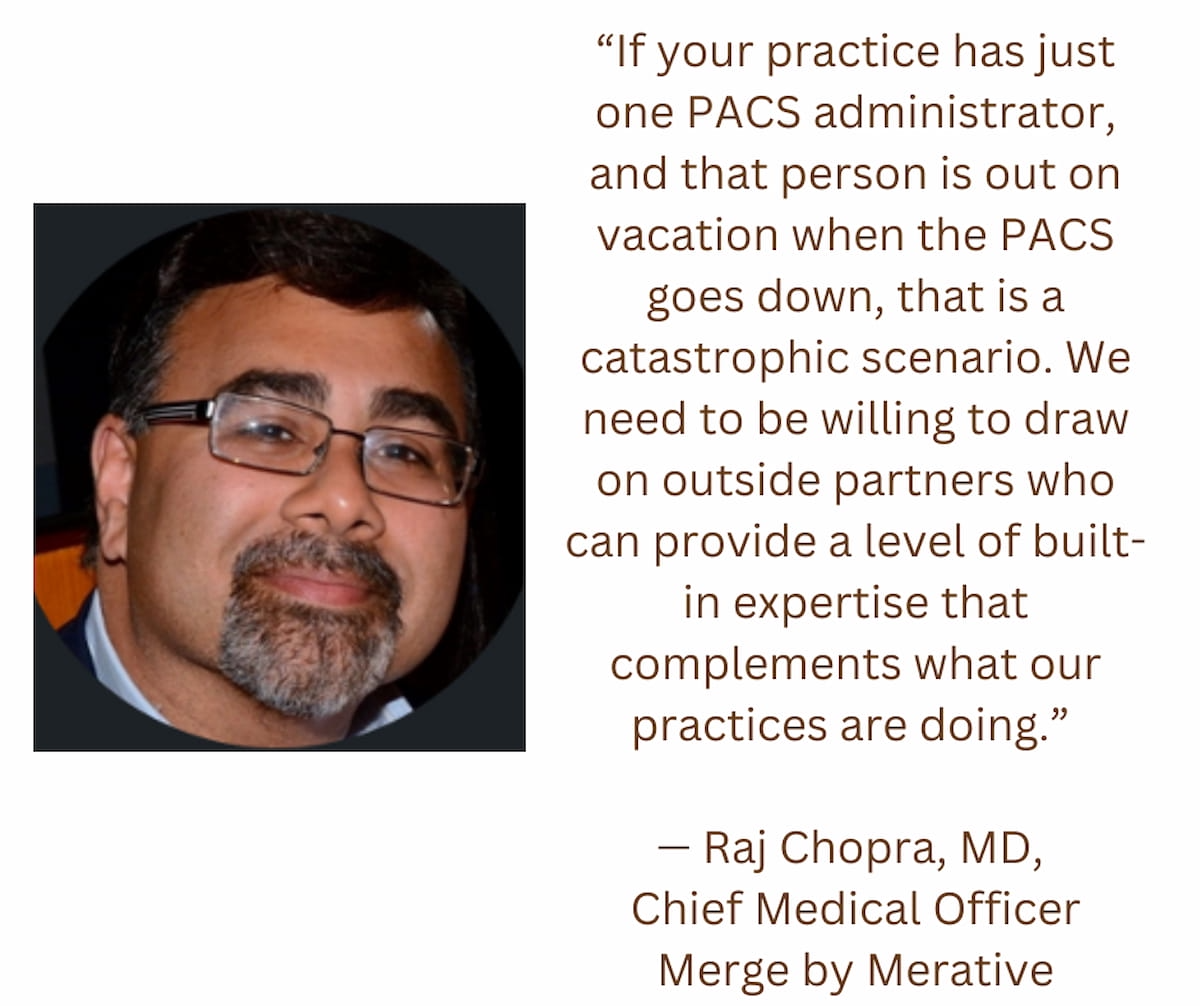Four Strategies to Address the Tipping Point in Radiology
In order to flip the script on the impact of the radiology workforce shortage, radiology groups and practices need to make sound investments in technologies and leverage partnerships to mitigate gaps in coverage and maximize workflow efficiencies.
We enter 2025 with radiology at a serious tipping point.
Physician shortages are getting worse. Due to burnout, retirements, and training and residency bottlenecks, fewer radiologists are available to handle the growing workload of patient images. I see many radiology groups scrambling to find the coverage they need. Everyone is now looking with a new sense of urgency for ways to improve efficiency.
There is no more slack in the system. It is good to acknowledge that reality. It means we can be clear-eyed about how to move radiology in an increasingly positive direction for clinicians like me, provider organizations, and especially for patients.
Here are four ways we can go about this in 2025.
1. Run Imaging like a Business with Investments in Workflow Technology
Many people might roll their eyes at “run radiology more like a business,” as if health care wasn’t already a business. However, clinical practices are increasingly looking at things in a more data- and financially driven way because some pieces of their practice are losing money, and there is no way to survive that.
We can run radiology practices like stronger businesses and make our physicians more efficient and better able to handle their workloads without burning out, all at the same time. It is not an either/or decision. We don’t need to pull back on technology investments but we do need to make smarter decisions on investments.
Workflow is central to all of this. Organizations that simplify their workflows — making it easier for radiologists to share images, automating certain processes to run in the background, and directing patient priors over to vendors faster — will go a long way in reducing the burdens on radiologists. Artificial intelligence and workflow orchestration can be effective tools in reducing click fatigue and helping to ensure more equitably balanced and intuitively assigned workloads. As a result, radiologists will no longer feel like they are drawing any short straws with their study volumes.

Running radiology practices and imaging organizations more like businesses doesn’t mean making decisions that prioritize money over patient care. It is just the opposite. It means making smarter investments into workflow solutions that eliminate friction among clinicians and technologists, reduce burnout, maximize efficiencies, and facilitate easier and faster reading and sharing of images.
2. Solve Cost and Burnout Conundrums with Geographic Arbitrage
I live on the West Coast so staffing my practice's 2 a.m. to 8 a.m. shift can be difficult. There are often few volunteers for the graveyard shift, and the imaging volumes during that stretch are often not high enough to justify the salaries for staffing those hours. Practices literally can’t afford their radiologists for that period, but they also can’t let exams sit idle for those hours.
Geographical arbitrage is the ideal way forward for addressing this issue. The smartest thing a West Coast practice can do in this situation is contract with an East Coast company to manage these workloads. After all, it’s only 5 a.m. to 11 a.m. Eastern time. That involves setting up a host of new processes – timely image transfer between practices, making sure the East Coast partners can easily call up priors from the West Coast, and figuring out the logistics for processes like billing.
This model of geographic arbitrage will become essential to making sure imaging volumes don’t go unaddressed while also avoiding the cost and burnout pitfalls of staffing enough clinicians to read them.
3. Pull Out of the Residency Burnout Loop
A recent study found that the time radiologists spent training residents between 2008 and 2019 dropped significantly from 35 percent to 26 percent. In that same period, clinical workloads rose by 80 percent.1
This is a self-perpetuating problem. Practices are opening fewer residencies because their doctors are already reading so many exams in a short amount of time. The idea of spending any amount of time explaining studies to residents just isn’t feasible. It's faster and “easier” for the clinicians to read it themselves. But that means the radiologist is taking on more work, becoming more prone to burnout. It also does a disservice to the next generation, who aren’t getting the exposure to image reading needed to become adept radiologists.
Imaging practices need to invest in technology solutions that can reduce the workload on their radiologists. This will not only reduce burnout and increase clinician happiness but also allocate more time for residency training. Failing to pull out of this loop will only continue to exacerbate burnout among radiologists and ensure an inadequate supply of residents and new radiologists to fill the ranks in the future.

4. Leverage Partners to Maximize Technology Investments
If there is a common thread to my previous three recommendations, it is the need to invest in new technology to make our workflows more efficient, reduce burnout-inducing backlogs, and create space for residencies and the next generation of radiologists.
But it’s not enough to spend the money on a product. You need the expertise available to get the most out of it. Imaging practices simply don’t have every kind of expertise available on hand to do so. It’s not practical. This is especially true for smaller organizations.
Economies of scale and outside expertise will be essential to how imaging practices continue to evolve this year. If your practice has just one PACS administrator, and that person is out on vacation when the PACS goes down, that is a catastrophic scenario. We need to be willing to draw on outside partners who can provide a level of built-in expertise that complements what our practices are doing. Nobody can be everything whether it is IT, clinical, billing, coding, you name it. We need partners who provide the resources to shore up these gaps.
More than that, these partners can help ensure we maximize our investments in technology. For instance, if a West Coast practice spends money on a new vendor-neutral archive that makes it easier to share images with its East Coast counterpart, it requires a certain level of personal health information security that is vetted and can reliably secure image transfers. Partners can provide the processes and expertise to do that vetting, in effect validating the investment we put into new solutions to improve our workflows.
Generative AI is another example of an innovation that promises to make life much easier for radiologists in the long run, perhaps even in 2025. It will help radiologists by making us more consistent, less likely to miss something, and supplying providers with more information for patient care management. This will involve not just partners but entire ecosystems of partners who will prove invaluable for individual practices to vet the technology and ensure they’re getting the most value out of it.
Moving Radiology Forward in 2025
There is no more slack in the radiology field. That may be a good thing. Necessity is the mother of invention, and for all the headwinds we have been running against the last several years, there is reason to be optimistic that 2025 presents bold and exciting opportunities to move our field in a positive direction again.
We need to be clear-eyed about our soft spots. More importantly, we need to be willing to make the decisions on technology investments, partnerships, and training the next generation of radiologists that can help our practices and profession thrive now and in the future.
Dr. Chopra is the chief medical officer for Merge by Merative. With over 20 years of clinical experience as a board-certified radiologist, Dr. Chopra has been actively involved in various advisory roles, helping to guide many organizations on imaging AI, FDA regulations, billing and coding, claims processing, utilization reviews, and Medicare/Medicaid compliance.
Reference
1. Burns J, Chung Y, Rula EY, Duszak R, Rosenkrantz AB. Evolving trainee participation in radiologists’ workload using a national Medicare-focused analysis from 2008 to 2020. J Am Coll Radiol. 2025;22(1):98-107.
The Reading Room Podcast: Emerging Trends in the Radiology Workforce
February 11th 2022Richard Duszak, MD, and Mina Makary, MD, discuss a number of issues, ranging from demographic trends and NPRPs to physician burnout and medical student recruitment, that figure to impact the radiology workforce now and in the near future.
Could AI-Powered Abbreviated MRI Reinvent Detection for Structural Abnormalities of the Knee?
April 24th 2025Employing deep learning image reconstruction, parallel imaging and multi-slice acceleration in a sub-five-minute 3T knee MRI, researchers noted 100 percent sensitivity and 99 percent specificity for anterior cruciate ligament (ACL) tears.